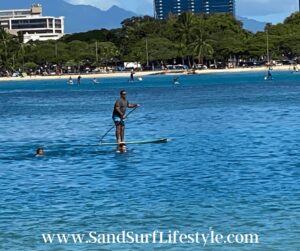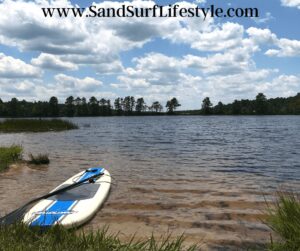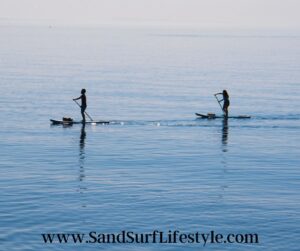When trying something new, such as paddle boarding, it may be intimidating when you fall off. No one is expected to do something right the first time they try it, so I have created a guide for you to follow on how to get back on the paddleboard after falling off to help take some of the guesswork out of the equation for you. Two different methods are mentioned to show that you do have options when learning how to get back on a paddleboard.
1. Properly Fall Off the Paddle Board
Falling off a paddle board improperly can cause some serious injuries that could be easily avoided. I am going to cover a few easy tips to keep in mind as you fall off to help prevent injuries.
- Do not overthink it – if you realize that you are unstable and there is a good chance of you falling off the board just fall off. This allows you to properly control your fall, allowing you to position yourself off the front or back of the board.
- Avoid hitting your board whether that means falling on it or having a board leash that pulls it back towards you. The board is dense and built to be tough so colliding with it can seriously injure you.
- If you are able to fall on your own terms, try to land on your front or back while laying horizontal. This can prevent you from knocking into any objects or things in the water.
2. Having the Correct Position
 When it comes to pulling yourself up and out of the water, it can be a difficult thing for some, I know that I struggle with it. So, ensuring that you have the proper form and positioning to do so goes a long way.
When it comes to pulling yourself up and out of the water, it can be a difficult thing for some, I know that I struggle with it. So, ensuring that you have the proper form and positioning to do so goes a long way.
- Keep your cool – getting distracted and confused can only hurt you in this situation such as making you lose your board. So, take a moment and prepare to get back on your paddle board.
- The middle of the board tends to be the strongest point, allowing it to help hold your weight as you pull yourself up. This point should be around the boards handle making it easy to find.
3. Using the Proper Hand
Ensuring that you are utilizing the proper hand when trying to get back up is just as important as using the right hand to throw a baseball or pass a football. Each activity has its own way and following the directions can really help you out.
- Once you are in the proper position you will use your dominant hand to lift your body up and out of the water and back onto the board. As you do this, your non-dominant hand will be holding the board in place. Your dominant hand is the one going towards the middle of the board to balance your weight and allow you to pull yourself up.
- The side you get up from matters as well, since I am right-handed, I would utilize the left side of my board to get back up and vice versa for someone who is left-handed. This is important as it offsets the arm you are reaching across the board with, making it easier to accomplish.
How To Improve Surf Paddling In Four Easy Steps. Learn more here.
4. Find a Solid Seated Position
- Once you pull yourself out of the water and back onto the board, you will want to put your legs on either side of the board until you are in a sitting position.
- After getting back onto the board, you should find yourself in a comfortable seated position. This is essential as it helps you to find your balance on the board again before standing back up, letting your body have a bit more time to get acclimated to the position.
 5. Stand and Continue Paddle Boarding
5. Stand and Continue Paddle Boarding
- At this point, you should be feeling comfortable being back on the board and prepared to try again.
- The key to doing this step successfully is ensuring that you go slow and have the proper footing. Keep the paddle on the board, diagonally across tends to work best for most people, ensure that the soles of your feet are solid on the board as you begin to move your weight towards the front of the board. Now begin to rise slowly, until you are in an upright position, fully standing up.
Now you know the easiest way to get back on a paddle board after falling off. While it may seem like there are a few steps to follow, it does not feel that way as you move through the motions in the water. It is a quick process that anyone can follow to get back up on their paddle board.
However, if this method does not work for you there is another option for you to try. This one is more straightforward and has fewer steps to it. So, there is no need to be deterred if your first few attempts at the first method do not go as planned because we have you covered.
The Back of the Board Method:
This method begins at the back of your board with you being able to see and focus on the tail of the board. I would recommend being closer to the side opposite of your dominant hand again to ensure that you can properly grasp the board when needed. You then need to grab the end of the board while pushing it below the water while you rise out of it, allowing you to sit on the end of it. After that, you just need to sit on the board and slowly position yourself back in a comfortable position preferably towards the middle of the board.
 While this method may seem easier it does still require some practice and can be intimidating at first. You can also reference step 1 from the other method mentioned previously to ensure that you are properly falling, when possible, to avoid any unnecessary injuries.
While this method may seem easier it does still require some practice and can be intimidating at first. You can also reference step 1 from the other method mentioned previously to ensure that you are properly falling, when possible, to avoid any unnecessary injuries.
As we discussed in this article there are two main ways in which you can get back on a paddle board after falling off. Whichever method you chose can help you get back on a paddleboard in no time to continue enjoying your adventure!
Please note: This blog post is for educational purposes only and does not constitute legal or medical advice. Please consult a legal expert or medical professional to address your specific needs.


 5. Stand and Continue Paddle Boarding
5. Stand and Continue Paddle Boarding